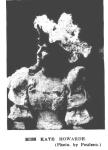In reviewing the 1897 Brisbane season, the Brisbane Courier records that were it not 'for the enterprise of Miss Kate Howarde there would probably have been no pantomime this year... [and] the public appreciation was manifested by the presence of an audience which literally crowded the Gaiety Theatre to the doors. Many people were unable to obtain seats.'
In relation to the production itself, the critic writes:
'The ordinary book of the pantomime was enlivened by various local allusions, which, if in one or two instances of a rather personal character, were on the whole, pointed and effective. The allusion, for instance, to the delay in the wood paving at once struck home, and in one or two references to the Merkara case, excited the risible faculties of the audience. Taken altogether, [however], the book was not as smartly local as it might have been, but that could hardly have been expected with a company so new to town and so unfamiliar with its most salient questions' (28 December 1897, p.5).
The 1899 version comprised the following scenes:
Act 1:Scene 1. Under the Sea;
Scene 2. Port of Cadiz.
Act 2: Scene 1. Wreck of the Hesperis;
Scene 2. Diamond Valley.
Act 3: A Nautical Tableaux of Great Britain and America,
Transformation Scene; and
Harlequinade.
Songs known to have been presented within the 1897 production were 'Sinbad, Don't You Go to Sea' and 'Mary Ann Maginty' (performed by Kate Howarde) and 'Bedouin Love Song' (Arthur Hunter).
The 1899 production included 'The Carnival' and 'I Was Dreaming' (sung by Violet Bertram), 'Only Once More' (Dorothy L'Estrange), 'I Want You Ma Honey' (Myra James), 'Sons of the Sea' and 'Soldiers of the Queen' (Arthur Hunter), 'If I hadn't Been So Shy' (Sydney Carden) and 'The Dandy Fifth' (Minnie Shipp, Therese Leoni, and Myra James).

